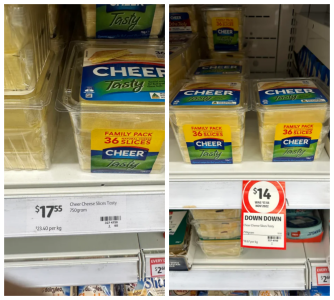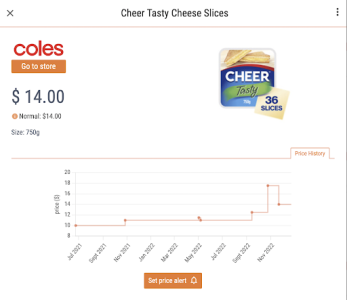Feel manipulated by supermarkets’ dishonest markdowns? You’re not alone
We all want great deals and savings, especially during these current periods of high inflation when prices for almost everything are soaring and we see a decrease in our purchasing power. The temptation to grab anything on sale to get your money’s worth is tempting, but are we really getting the best prices?
If you feel like the sale tags you’re seeing these days are too good to be true, you’re not the only one. On Reddit, price-conscious Aussies were recently discussing supermarket practices that are possibly dishonest and misleading.
For example, one user noticed that the price of Cheer Tasty slices had increased from its ‘regular’ price of $11 to $17.55 for two weeks but then was brought ‘down down’ to $14, leading members of the Australian Personal Finance subreddit to discuss their observations on their local groceries.

Before and after: is it really a ‘down down’ price, or are shoppers being tricked into thinking they’re getting a great deal? Credit: Reddit
A top comment said: ‘They did this before the pandemic, raising prices, dropping them to more than they originally were, and then patting themselves on the back and praising themselves for low prices.’
Another chimed in: ‘It’s disgusting and they know it sells because you see a ‘down down’ tag and automatically assume you are on the winning side. I wouldn’t call that a low price.’
A third commented: ‘It's merchandising basics, really. One of my first jobs was as an activation rep for an alcohol company and we'd always put a bright neon starburst tag on anything that wasn't selling with ‘only $x!’ on it. It would then start to sell.’

According to a price tracking website, PriceHipster, the ‘sale’ price of $14 on the item is still 40% more than it was in November last year.
It is, indeed, a practice that has been around even before the pandemic. And it’s not only in Australia – dodgy deals have also been noticed in neighbouring countries such as New Zealand.
Someone said: ‘It’s a sh***y practice. Coles introduced their new nut bars for $6 a pack a few months ago, and I thought, ‘Jeez, that's expensive.’ Lo and behold, a month later, they were ‘down down’ to their new price of $4.’
A commenter tried to defend the practice by saying: ‘Huh? Isn't that how literally every retail store works, ever? New products/stock are priced high, then lowered in price if they can't sell it all at that price point.’
Another user pointed out what’s wrong with this strategy: ‘It isn't a discount to move a product that isn't selling. It was pretty clear that $6 was never going to be the actual price for a pack of 5 basic nut bars.’ They continued: ‘Instead, it was an artificial price point so that they could then promote it at a reduced price.’
It’s probably even more glaring in December, as one user shared: ‘They're literally doing it for Christmas stock right now. Get a small amount of stock a month early with prices no one will pay, and then suddenly, come December, the ‘sale prices’ are "discounted" every week.’
The practice could be categorised as ‘misleading price displays’. According to the Australian Competition and Consumer Protection (ACCC), ‘Businesses must not display prices that are wrong or likely to create a false impression. This includes prices displayed in stores, in advertising, or whenever communicating with customers.’
According to the ACCC, some examples of misleading price displays include the following:
This is how one Redditor puts it: ‘If people bought the product at a higher price, in some cases, that's enough to establish that the product was at that higher price to now show a sale. If there were no sales but it can be established that the product was at that higher price for a reasonable amount of time, that shows that a consumer could have bought at that price, then that is also sometimes accepted.’
When grocery shopping, it pays to remember that everything inside a supermarket is designed to make you stay longer and spend more money, from the layout to the lighting. Even colours can push us to buy – did you know that bananas with peels that were Pantone colour 12-0752 (Buttercup) were more likely to sell than when they’re slightly brighter?
In 1982, a popular study also found that stores with background music saw customers spend 34 per cent more time shopping, which also meant more revenue. Other research revealed that we are only rationally selective when shopping within a 40 minute time period. Beyond that, people are more likely to shop emotionally, spending at least 50 per cent more on things they did not intend to buy when first going in.
How do you avoid the psychological traps in supermarkets, then? The National Geographic’s advice is simple: ‘Make a list and stick to it. Try not to shop so often – fewer and more efficient trips to the store are easier on the pocketbook – and don’t shop when you’re hungry.’
What do you think, folks? Have you encountered misleading sale tags in your local supermarkets? Let us know in the comments!
If you feel like the sale tags you’re seeing these days are too good to be true, you’re not the only one. On Reddit, price-conscious Aussies were recently discussing supermarket practices that are possibly dishonest and misleading.
For example, one user noticed that the price of Cheer Tasty slices had increased from its ‘regular’ price of $11 to $17.55 for two weeks but then was brought ‘down down’ to $14, leading members of the Australian Personal Finance subreddit to discuss their observations on their local groceries.

Before and after: is it really a ‘down down’ price, or are shoppers being tricked into thinking they’re getting a great deal? Credit: Reddit
A top comment said: ‘They did this before the pandemic, raising prices, dropping them to more than they originally were, and then patting themselves on the back and praising themselves for low prices.’
Another chimed in: ‘It’s disgusting and they know it sells because you see a ‘down down’ tag and automatically assume you are on the winning side. I wouldn’t call that a low price.’
A third commented: ‘It's merchandising basics, really. One of my first jobs was as an activation rep for an alcohol company and we'd always put a bright neon starburst tag on anything that wasn't selling with ‘only $x!’ on it. It would then start to sell.’

According to a price tracking website, PriceHipster, the ‘sale’ price of $14 on the item is still 40% more than it was in November last year.
It is, indeed, a practice that has been around even before the pandemic. And it’s not only in Australia – dodgy deals have also been noticed in neighbouring countries such as New Zealand.
Someone said: ‘It’s a sh***y practice. Coles introduced their new nut bars for $6 a pack a few months ago, and I thought, ‘Jeez, that's expensive.’ Lo and behold, a month later, they were ‘down down’ to their new price of $4.’
A commenter tried to defend the practice by saying: ‘Huh? Isn't that how literally every retail store works, ever? New products/stock are priced high, then lowered in price if they can't sell it all at that price point.’
Another user pointed out what’s wrong with this strategy: ‘It isn't a discount to move a product that isn't selling. It was pretty clear that $6 was never going to be the actual price for a pack of 5 basic nut bars.’ They continued: ‘Instead, it was an artificial price point so that they could then promote it at a reduced price.’
It’s probably even more glaring in December, as one user shared: ‘They're literally doing it for Christmas stock right now. Get a small amount of stock a month early with prices no one will pay, and then suddenly, come December, the ‘sale prices’ are "discounted" every week.’
The practice could be categorised as ‘misleading price displays’. According to the Australian Competition and Consumer Protection (ACCC), ‘Businesses must not display prices that are wrong or likely to create a false impression. This includes prices displayed in stores, in advertising, or whenever communicating with customers.’
According to the ACCC, some examples of misleading price displays include the following:
- Stating the sale price is marked down from an earlier price when:
- the items were not sold at that price in a reasonable period right before the sale started, or
- only a very small proportion of items were sold at that price right before the sale.
- Comparing the displayed price with an incorrect cost or wholesale price.
- Comparing the displayed price to a recommended retail price (RRP) that no one generally charges for the product.
- Promoting a price as being a sale or special price, when it is actually the normal price. Where an item is offered at a sale or special price for an extended period of time, it may be misleading to call it a sale or special price, as the price has effectively become the new selling price.
- Advertising a price that is not the total price the consumer will have to pay.
This is how one Redditor puts it: ‘If people bought the product at a higher price, in some cases, that's enough to establish that the product was at that higher price to now show a sale. If there were no sales but it can be established that the product was at that higher price for a reasonable amount of time, that shows that a consumer could have bought at that price, then that is also sometimes accepted.’
When grocery shopping, it pays to remember that everything inside a supermarket is designed to make you stay longer and spend more money, from the layout to the lighting. Even colours can push us to buy – did you know that bananas with peels that were Pantone colour 12-0752 (Buttercup) were more likely to sell than when they’re slightly brighter?
In 1982, a popular study also found that stores with background music saw customers spend 34 per cent more time shopping, which also meant more revenue. Other research revealed that we are only rationally selective when shopping within a 40 minute time period. Beyond that, people are more likely to shop emotionally, spending at least 50 per cent more on things they did not intend to buy when first going in.
How do you avoid the psychological traps in supermarkets, then? The National Geographic’s advice is simple: ‘Make a list and stick to it. Try not to shop so often – fewer and more efficient trips to the store are easier on the pocketbook – and don’t shop when you’re hungry.’
What do you think, folks? Have you encountered misleading sale tags in your local supermarkets? Let us know in the comments!







